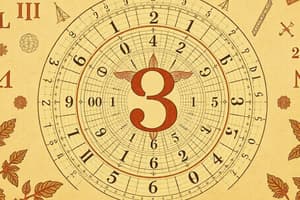Podcast
Questions and Answers
What does a derivative measure in a function?
What does a derivative measure in a function?
- The maximum value of the function
- The average value over an interval
- The instantaneous rate of change (correct)
- The total area under the curve
Which of the following is NOT a measure of central tendency?
Which of the following is NOT a measure of central tendency?
- Mean
- Median
- Variance (correct)
- Mode
In trigonometry, which function is used to find the ratio of the opposite side to the hypotenuse in a right-angled triangle?
In trigonometry, which function is used to find the ratio of the opposite side to the hypotenuse in a right-angled triangle?
- Cosine
- Secant
- Tangent
- Sine (correct)
What is the primary purpose of data analysis in statistics?
What is the primary purpose of data analysis in statistics?
Which of the following describes a probability distribution?
Which of the following describes a probability distribution?
What is the main focus of arithmetic?
What is the main focus of arithmetic?
Which term describes the fixed numerical value in algebra?
Which term describes the fixed numerical value in algebra?
Which of the following is a characteristic of polygons?
Which of the following is a characteristic of polygons?
What is the fundamental concept of differential calculus?
What is the fundamental concept of differential calculus?
Which of the following operations is related to breaking a number into equal parts?
Which of the following operations is related to breaking a number into equal parts?
What is an expression in algebra?
What is an expression in algebra?
What defines a circle in geometry?
What defines a circle in geometry?
What is the main purpose of integral calculus?
What is the main purpose of integral calculus?
Flashcards
What is Arithmetic?
What is Arithmetic?
Arithmetic is a branch of mathematics focused on basic operations with numbers like addition, subtraction, multiplication, and division.
What is addition?
What is addition?
Addition is the process of combining two or more numbers to find their sum.
What is subtraction?
What is subtraction?
Subtraction is the process of finding the difference between two numbers.
What is multiplication?
What is multiplication?
Signup and view all the flashcards
What is division?
What is division?
Signup and view all the flashcards
Derivative
Derivative
Signup and view all the flashcards
Integral
Integral
Signup and view all the flashcards
Statistics
Statistics
Signup and view all the flashcards
Trigonometric Functions
Trigonometric Functions
Signup and view all the flashcards
Unit Circle
Unit Circle
Signup and view all the flashcards
Study Notes
Arithmetic
- Arithmetic is the branch of mathematics dealing with basic operations on numbers, such as addition, subtraction, multiplication, and division.
- It forms the foundation for more advanced mathematical concepts.
- Fundamental operations:
- Addition: Combining two or more numbers to find their sum.
- Subtraction: Finding the difference between two numbers.
- Multiplication: Repeated addition of a number.
- Division: Breaking a number into equal parts.
- Properties of operations: Understanding the rules that govern these operations (e.g., commutative, associative, distributive properties).
Algebra
- Algebra is a branch of mathematics that uses symbols, often letters, to represent unknown values or quantities.
- It uses equations and inequalities to solve problems involving variables.
- Variables: Symbols used to represent unknown values (e.g., x, y, z).
- Constants: Fixed numerical values (e.g., 2, 5, -10).
- Expressions: Combinations of variables and constants using mathematical operations.
- Equations: Statements that show two expressions are equal.
- Inequalities: Statements that show two expressions are not equal (e.g., greater than, less than).
- Solving equations: Finding the values of variables that make an equation true.
- Solving inequalities: Finding the ranges of values that make an inequality true.
Geometry
- Geometry deals with shapes, sizes, and positions of figures in space.
- It involves studying points, lines, angles, polygons, circles, and three-dimensional figures.
- Basic shapes: Points, lines, planes, angles.
- Polygons: Two-dimensional shapes with straight sides. Common polygons include triangles, quadrilaterals, pentagons, hexagons, etc.
- Circles: A set of points equidistant from a central point.
- Three-dimensional figures: Solids like cubes, spheres, cylinders, cones, pyramids.
- Properties of shapes: Understanding the characteristics of different shapes, such as angles, sides, and area.
- Area and perimeter: Calculating the space enclosed by a two-dimensional shape and the distance around it.
- Volume: Calculating the space occupied by a three-dimensional shape.
Calculus
- Calculus is a branch of mathematics that deals with continuous change.
- It involves two main branches:
- Differential calculus: Studies rates of change and slopes of curves. Fundamental concept is the derivative.
- Integral calculus: Studies areas under curves and accumulation of quantities. Fundamental concept is the integral.
- Derivatives: Measures the instantaneous rate of change of a function.
- Integrals: Calculate the accumulation of a function over an interval.
- Applications: Used in physics, engineering, economics, and other fields to model and solve problems related to motion, growth, and other continuous processes.
Statistics
- Statistics is the science of collecting, organizing, analyzing, interpreting, and presenting data.
- Data collection: Gathering information from various sources, potentially observational, experimental or otherwise.
- Data organization: Arranging collected data into tables, charts, or graphs to aid understanding.
- Data analysis: Applying various methods to determine patterns, trends, and relationships within the data.
- Data interpretation: Drawing conclusions and making predictions based on analyzed data.
- Measures of central tendency: Mean, median, and mode (represent typical values).
- Measures of dispersion: Range, variance, and standard deviation (represent data spread).
- Probability: The mathematical study of the likelihood of events occurring.
- Probability distributions: Distributions of different probabilities to model events.
Trigonometry
- Trigonometry is a branch of mathematics that deals with the relationships between angles and sides of triangles.
- Trigonometric functions: Sine, cosine, tangent, cotangent, secant, and cosecant are used to relate angles and sides.
- Applications: Used in surveying, navigation, and engineering problems that involve triangles.
- Right-angled triangles: Focuses on relationships in right triangles, with special emphasis on sine, cosine, and tangent functions in relation to their angles and sides.
- Unit Circle: Geometric representation that connects trigonometric functions to angles and coordinates on a circle.
Studying That Suits You
Use AI to generate personalized quizzes and flashcards to suit your learning preferences.




